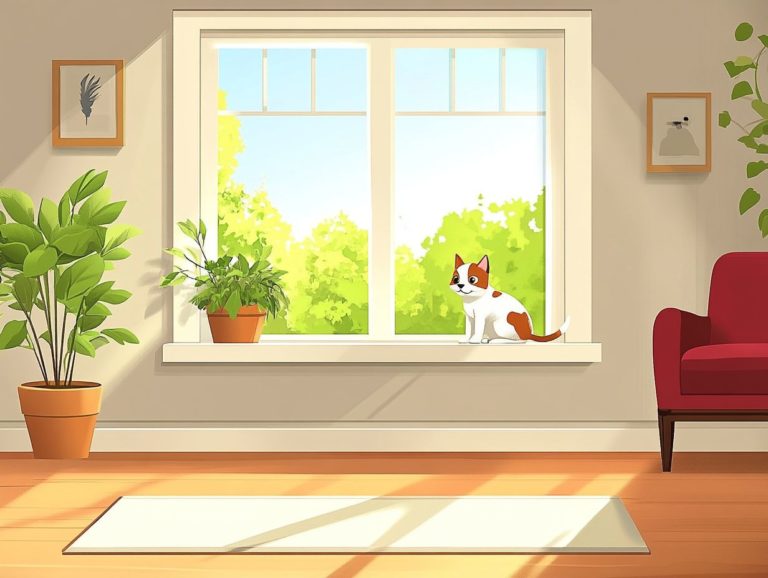Outdoor Spaces: How They Impact Pet Anxiety
Many pet owners might overlook the vital role outdoor spaces play in their furry friends’ mental well-being. Just like humans, pets can experience anxiety, and their environment significantly influences this.
This article explores the connection between outdoor settings and pet anxiety. It helps you recognize common signs of stress, uncover various causes, and discover effective strategies to create serene outdoor spaces.
It also touches on behavioral training, therapeutic options, and medication for managing anxiety in pets. By understanding these aspects, you can enhance your pet’s quality of life, ensuring they thrive in both body and spirit.
Contents
- Key Takeaways:
- The Link Between Outdoor Spaces and Pet Anxiety
- Signs of Pet Anxiety
- Causes of Pet Anxiety
- Improving Outdoor Spaces for Anxious Pets
- Other Strategies for Managing Pet Anxiety
- Frequently Asked Questions
- 1. What are outdoor spaces and how do they impact pet anxiety?
- 2. Can outdoor spaces help with my pet’s anxiety?
- 3. How can I use outdoor spaces to help my pet with anxiety?
- 4. Are certain outdoor spaces better for pets with anxiety, like those found in Chesapeake Bay or California?
- 5. How do outdoor spaces benefit a pet’s mental health and help prevent canine cognitive dysfunction?
- 6. Can outdoor spaces help to prevent pet anxiety, especially during stressful times like COVID-19?
Key Takeaways:

- Outdoor spaces, like dog parks, can transform your pet’s anxiety into joy!
- Spotting signs such as excessive barking or destructive behavior can help you recognize anxiety in your pet.
- Environmental factors, like loud noises, can trigger anxiety, but creating a calming outdoor space can help.
The Link Between Outdoor Spaces and Pet Anxiety
The connection between outdoor spaces and pet anxiety is crucial. The environment significantly influences your pets’ mental and physical health, especially for breeds like the Labrador. Understanding the impact of shelter life on pet anxiety can help create a healthier atmosphere for your furry friends.
Dog parks serve a pivotal role, offering vital physical activity and socialization opportunities. This engagement helps alleviate stress and anxiety.
Given the challenges posed by COVID-19, pet owners have come to appreciate the value of well-designed parks. These spaces promote exercise and foster interaction, ultimately enhancing the overall well-being of their beloved companions.
Understanding the Connection
Understanding the link between outdoor environments and pet anxiety is key for dog owners. Regular exercise and outdoor activities can greatly enhance your furry friend’s health and happiness.
Engaging with nature provides your dog with the necessary stimuli to unleash their curiosity and instincts. This promotes not just physical exercise but also mental engagement.
Exploring parks, trails, or even your backyard allows your dog to encounter various scents, sights, and sounds, boosting their thinking skills. This sensory stimulation and freedom to roam often lead to reduced anxiety and stress.
A well-exercised dog tends to be a happier and healthier one, strengthening the bond between you and your pet.
Signs of Pet Anxiety
Spotting pet anxiety signs is key to unlocking your dog s happiness! Recognizing these signs early allows you to implement effective management strategies for a more balanced life for your furry friend.
Identifying Common Behaviors

Identifying behaviors linked to anxiety in dogs is crucial for effectively addressing your pet’s emotional needs. Look for signs such as excessive barking during quiet moments, destructive tendencies when left alone, or even withdrawal and hiding.
These behaviors often signal underlying stress or discomfort. By understanding these actions, you can create a serene environment, implement calming techniques, and seek professional help when necessary.
This proactive approach alleviates your pet’s anxiety and strengthens the bond between you and your dog, ensuring a happier coexistence.
Causes of Pet Anxiety
Grasping the causes of pet anxiety is essential for dog owners. It enables you to cultivate a nurturing environment that fosters your pet’s overall health and well-being.
Environmental Factors and Triggers
Numerous environmental factors can cause anxiety in your dog. These factors can differ between indoor and outdoor settings, making it crucial to identify and address them.
For example, loud noises like thunderstorms or fireworks can send your dog into panic. This creates a lingering fear that may last long after the noise has faded. Unfamiliar places such as new parks or crowded spaces can overwhelm your dog, leading to heightened stress. They may navigate a barrage of unfamiliar smells, sights, and sounds. Poorly designed parks that lack quiet areas or sufficient space away from distractions can further escalate anxiety.
Fostering a secure and supportive environment is essential for your nervous pet. This helps them feel safe and gradually acclimate to potentially triggering situations, creating a more harmonious experience for both of you.
Improving Outdoor Spaces for Anxious Pets
Enhancing outdoor spaces for anxious pets is crucial for a peaceful environment that supports their overall health and well-being. By considering the role of space in reducing pet anxiety, you can significantly lower their anxiety levels, allowing them to thrive in a serene setting.
Creating a Calming Environment

Creating a calming environment outdoors can greatly alleviate anxiety in dogs, enhancing their health and well-being. Additionally, understanding the impact of your home’s layout on pet behavior can further contribute to a tranquil atmosphere for your pets.
Incorporate specific design elements, such as ample shade from strategically placed trees or canopies. This thoughtful approach allows your dogs to enjoy a comfortable retreat from the sun, giving them a chance to relax without overheating.
Establish quiet areas away from daily life s hustle and bustle. These sanctuaries serve as spaces where your pets can unwind, effectively minimizing stress and overstimulation.
Encourage friendly interactions among pets to foster a positive atmosphere. This promotes socialization and enriches their overall experience.
Adding water features like small ponds or fountains introduces soothing sounds that enhance tranquility, further encouraging relaxation for your furry companions.
Other Strategies for Managing Pet Anxiety
Exploring various strategies to manage pet anxiety is essential for dog owners focused on improving their pets’ health and well-being. By diving into effective methods, you can significantly enhance your dog’s quality of life and foster a more harmonious relationship.
Behavioral Training and Therapy
Implementing behavioral training, such as teaching commands and incorporating play with a tennis ball, along with therapy, is an effective approach to help dogs manage anxiety.
By emphasizing structured routines and positive reinforcement, these techniques strengthen the bond between you and your dog. They also establish a solid foundation for confidence-building exercises. Enrolling your canine companion in an obedience school can be particularly advantageous. It offers a controlled environment where dogs can master essential commands and social skills under expert guidance.
With professional support, you ll receive tailored strategies that address your dog s unique needs. This ensures the training effectively alleviates specific anxiety triggers. This comprehensive method can lead to remarkable improvements in your dog s demeanor, enabling them to navigate their surroundings with greater ease and comfort.
Your pet deserves a calm and happy life start making these changes today!
Medication Options
If behavioral strategies don’t work, medication options may provide relief for your anxious dog. Always consult a veterinarian for guidance.
There s a range of medications available, including medications to reduce anxiety and improve mood and natural supplements. Each is crafted to target specific symptoms and help lower stress levels in your furry friend. It’s important to know that medication isn t a universal remedy; its effectiveness can vary widely from one dog to another.
Consulting a vet is crucial for choosing the right treatment and monitoring your dog’s response. They can adjust dosages to ensure safety and comfort.
Frequently Asked Questions

1. What are outdoor spaces and how do they impact pet anxiety?
Outdoor spaces are any places outside your pet’s home, like parks or backyards. These areas can greatly impact pet anxiety, as they provide mental and physical stimulation, reduce stress levels, and promote overall well-being. Understanding the influence of environment on pet anxiety can help you create a more supportive atmosphere for your pet.
2. Can outdoor spaces help with my pet’s anxiety?
Yes, spending time in outdoor spaces can positively impact your pet’s anxiety. The sights, sounds, and smells of nature can help to calm and relax them while also providing an outlet for excess energy, as highlighted in understanding the impact of open spaces on pets.
3. How can I use outdoor spaces to help my pet with anxiety?
You can do many fun activities outdoors to help your pet feel better. Take them for regular walks or playtime in a park, create a designated outdoor space for them to relax, or even set up an agility course to keep them mentally and physically stimulated.
4. Are certain outdoor spaces better for pets with anxiety, like those found in Chesapeake Bay or California?
The best outdoor spaces for pets with anxiety are usually quiet, peaceful areas with minimal distractions. This could be a secluded spot in a park or a designated area in your backyard away from busy roads or loud noises. Understanding the impact of household items on pet anxiety can also help create a calming environment for your furry friends.
5. How do outdoor spaces benefit a pet’s mental health and help prevent canine cognitive dysfunction?
Outdoor spaces provide a variety of sensory experiences for pets, such as different textures, smells, and sounds. These experiences can help to reduce stress and promote relaxation, especially during transitions like moving, which can impact pet anxiety. Understanding the effects of moving on pet anxiety is crucial. They also offer opportunities for exercise and socialization, which are important for a pet’s overall mental well-being.
6. Can outdoor spaces help to prevent pet anxiety, especially during stressful times like COVID-19?
Wondering if outdoor spaces can help your pet, especially during stressful times like COVID-19? Yes! Regular outdoor time can lighten their mood. While some pets may be more prone to anxiety due to genetic or environmental factors, creating calm spaces for anxious pets can definitely help to prevent it. The mental and physical stimulation, as well as the calming effects of nature, can help to reduce stress and promote a happier, more relaxed pet.
Take your dog outside today and watch their anxiety melt away!






